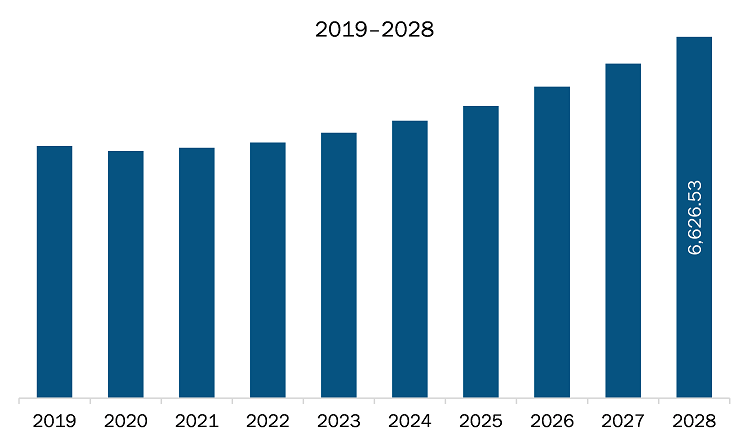The mechanical ventilation systems market in Europe is expected to grow from US$ 4591.47 million in 2021 to US$ 6626.53 million by 2028; it is estimated to grow at a CAGR of 5.4% from 2021 to 2028.
The residential sector consumes a significant amount of energy equivalent to one third of total primary energy resources available. Increase in building service demands and improvised lifestyle have further increased the energy consumption. Thus, energy-efficient ventilation systems, such as energy recovery ventilation (ERV), can drastically save energy by reducing the demands for electricity and power for heating and cooling and providing appropriate ventilation to residential or commercial buildings. Moreover, energy-efficient mechanical ventilation systems improve humidity control by pre-drying the incoming ventilation air. They also encourage building operators to improve quality of the indoor air and meet simplified building codes for consistent increase in energy consumption. Further, the integration of energy-efficient mechanical ventilators into the ductwork of residential or commercial buildings helps to achieve proper ventilation. The demands for energy-efficient ventilation system is further augmented for removing pollutants emitted by indoor sources. The high rates of air change can cause energy burden on a building’s heating or cooling needs. Ventilation accounts for 30% or more of space conditioning energy and has increased the demand to minimize ventilation rate, reduce energy, and ensure optimum indoor air quality. The proportion of airborne energy loss is much higher in buildings constructed at high standards of thermal insulation. The amount of energy consumed is dependent on the flow rate of ventilation and the amount of air conditioning necessary to achieve thermal comfort. Additional energy is needed to drive mechanical ventilation systems, cool air by refrigeration, and maintain humidity levels. Exponential growth in the rate of energy consumption and dissipation in the commercial and residential sectors have created an emphasis on energy conservation development, which has, in turn, increased the demand for energy-efficient mechanical ventilation systems.
Currently, the UK is the most impacted country by the COVID-19, followed by Russia, France, and Italy. Owing to implementation of containment measures such as travel restriction, shutdown of manufacturing facilities and businesses in the region the slewing bearing market witness a crunch from supply side. Moreover, as containment measures also affected the operation of end user of mechanical ventilation system which subsequently impacted the market from demand side. However, as containment measures were relaxed the mechanical ventilation system market started witnessing positive growth from the Q1 of 2021.
With the new features and technologies, vendors can attract new customers and expand their footprints in emerging markets. This factor is likely to drive the Europe mechanical ventilation systems market. The Europe mechanical ventilation systems market is expected to grow at a good CAGR during the forecast period.

- This FREE sample will include data analysis, ranging from market trends to estimates and forecasts.
Europe Mechanical Ventilation Systems Market Segmentation
Europe Mechanical Ventilation Systems Market – By Type
- Exhaust Ventilation
- Supply Ventilation
- Balanced Ventilation
- Energy Recovery Ventilation
Europe Mechanical Ventilation Systems Market – By Application
- Industrial
- Residential
- Commercial
Europe Mechanical Ventilation Systems Market – By Country
- France
- Germany
- Italy
- UK
- Russia
- Rest of Europe
Europe Mechanical Ventilation Systems Market – Companies Mentioned
- Vortice
- BLAUBERG
- Infineon Technologies AG
- AERMEC
- Mitsubishi Electric Corporation
- Volution Group plc.
- DUCO Ventilation & Sun Control
- Caladair International
- Airflow Developments Limited
- Mechanical Air Supplies Ltd.
Europe Mechanical Ventilation Systems Report Scope
| Report Attribute | Details |
|---|---|
| Market size in 2021 | US$ 4591.47 Million |
| Market Size by 2028 | US$ 6626.53 Million |
| CAGR (2021 - 2028) | 5.4% |
| Historical Data | 2019-2020 |
| Forecast period | 2022-2028 |
| Segments Covered |
By Type
|
| Regions and Countries Covered |
Europe
|
| Market leaders and key company profiles |
|
- Historical Analysis (2 Years), Base Year, Forecast (7 Years) with CAGR
- PEST and SWOT Analysis
- Market Size Value / Volume - Regional, Country
- Industry and Competitive Landscape
- Excel Dataset
Recent Reports
Testimonials
Reason to Buy
- Informed Decision-Making
- Understanding Market Dynamics
- Competitive Analysis
- Identifying Emerging Markets
- Customer Insights
- Market Forecasts
- Risk Mitigation
- Boosting Operational Efficiency
- Strategic Planning
- Investment Justification
- Tracking Industry Innovations
- Aligning with Regulatory Trends





















 Get Free Sample For
Get Free Sample For